Clipping is a very important part of preparing a Miniature Horse for the show ring.
Lisa Navrat of Walton recognized that even the best halter horse may not win if it is not properly prepared and groomed.
Assisted by her husband, Joe, Navrat demonstrated those procedures as a highlight of the Heartland Miniature Horse Club Fun Show and Clinic near Ozawkie.
Enthusiasts from throughout the Midwest were in attendance for the two-day activity hosted by Larry and Sue Elniff, prominent Miniature Horse breeders, exhibitors and leaders, at their picturesque Little Bit O Country Miniature Horse Farm.
For nearly two decades, the Navrats have collected countless awards with their world-renown Miniature Horses. “The industry has changed a lot, and it has been for the best,” emphasized Navrat, as she demonstrated grooming procedures on a Miniature Horse provided by the Elniffs.
Time and patience are keys to clipping a horse. “Make sure you allow yourself enough time. Don’t try to do it right before a show,” Navrat stressed. “A beginner might take as long as eight hours to clip a horse, but as you gain experience, it’ll go faster.”
Equipment is important, but the most expensive is not necessary. “Many farm stores have small electric clippers that will work okay. Sometimes, the economical barber’s sets at discount stores work fine to start out,” she advised.
Cleanliness is essential to help improve the final product, but most importantly reduces wear on clipper blades. “Again, the costly shampoos aren’t needed, but make sure you do a thorough job getting all of the dirt off your horse,” Navrat continued.
According to the expert, clipping should begin at the hind quarters and proceed forward with the head and legs last. “The horse might be a bit skittish of clipping at the start,” she noted. “But by the time you get to the head and ears, they’re generally accustomed to the noise and feeling.”
For horses that are very nervous, it does no good to reprimand them into submission. “Most horses get used to it rather quickly. Sometimes a twitch will be helpful in the beginning,” Navrat discussed. “Working with the horse’s legs, head and ears, and exposing it to various noises and environments prior to clipping-day are beneficial.”
Various methods of holding the clippers are preferred by different people. “I keep the head of the clippers flat against the body, but it all boils down to the individual and what works best for them,” Navrat reviewed. “This will come with time and experience.”
Actually, it’s best to do the clipping at least a couple of days ahead of the show. “Then the hair has time to grow out a little bit and cover up the blade marks which will often occur, especially for those less experienced in the clipping procedure,” Navrat indicated.
Heads require some of the most precise clipping, according to Navrat. “A finer blade is better for getting around the ears and muzzle,” she recommended. “Halters can drastically alter the looks of a horse’s head. It’s important to clip the head so it is further enhanced by the halter.”
Freshly-clipped horses, especially those with light-colored hair and pale skin, will readily sunburn if turned back outside. “They should be kept inside and just allowed out at night,” Navrat said.
While the horse was trimmed from back to front, Navrat did not shape the hairs about the tail head in the first time over. “It’s important to enhance the tail set when clipping,” she directed. “Leaving the hairs longer higher up the croup will often give judges the visual image of a fuller, rounder hip.”
Lubrication is essential for the clippers. “They must be well oiled, clean and cool,” Navrat related. “Sometimes, I switch blades so they don’t become too hot.”
Chestnuts, a growth on the inside of horses’ legs, should be peeled or trimmed off, and sometimes even sanded, so they aren’t a distraction from the horse’s appearance.
Bringing out a storage bag filled with various halters, Navrat showed that the halter can make or break the horse’s head appearance. “The wrong halter on a nice head can be a distractive. I’ve learned that the hard way,” she admitted.
Hoof trimming must be done well ahead of the show. “Some exhibitors like to have it done the day before a show, so their horse won’t be as tall and be eligible for a lower height class,” Navrat admitted. “However, they can easily be trimmed too short, making them lame. That will disqualify a horse, and make a bad public image, too.”
Hooves should be sanded or buffered before applying hoof black. “A variety of hoof dressings are available, and again it generally boils down to personal preference,” Navrat commented. “I like to use a hoof color remover after the show.”
Manes and tails are usually preferred to be long and flowing. “They actually require lots of care throughout the year, and then the final styling won’t be so difficult,” Navrat suggested.
The rough-looking mane on the demonstration horse carefully was clipped from underneath, as well as along the top of the neck, so it lay smoothly and attractively enhanced the horse’s image. The horse’s tail was brushed gently to prevent damage.
Hair set or gel is sometimes applied to keep unruly hairs positioned. “I generally use this on the tail head and the forelock,” she stated.
Fly spray helps keep the horse calm in the ring. “Finishing spray should be applied right before walking into the show ring, because it will collect dust, and you sure don’t want that after doing the work to get your horse fitted and groomed,” Navrat explained.
With all of this advance preparation, the horse still must be shown to its best advantage throughout the entire competition in order to win awards, Navrat concluded.
+++
